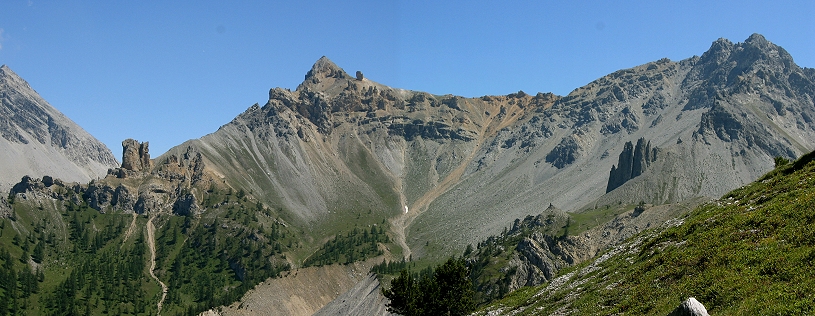
Variant GR5B, above Col d'Echelle - the barely visible track crosses the huge face in the middle to the saddle at the left edge of the photo.
Send any comments to the maintainer Roger Caffin
Mouse-over pics will give captions

Variant GR5B, above Col d'Echelle - the barely visible track crosses the huge face in the middle to the saddle at the left edge of the photo.
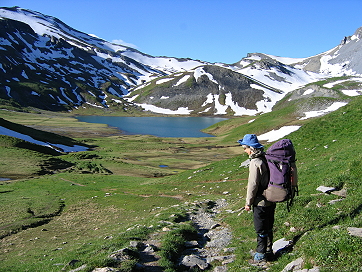
In 2007 my wife and I spent 3 months walking several GR tracks in France, with very little up-front organisation. Really, it was very easy to organise, although we did benefit from our experiences with the GR10 and GR11. Once again it was really just a matter of deciding what to take, packing, and going. Oh well - there were a few bits of organisation worth mentioning.
It's very simple. We flew to Paris and took a train to the start. The French trains are pretty good. But during the peak season you should try to book seats on the train in advance, otherwise you may find yourself standing the whole way. Yes, they do sell more tickets than they have seats. Ah well...
The letters 'GR' stand for Grande Randonnée in France, or Long Walk. There are lots of them, hence the numbers. In France the FFRP (the national umbrella organisation of walking clubs) actually owns the registered name 'GRnn' and the design of the special markers ('balisage') used. They control and maintain these walking tracks, and defend them (in court) against land owners who want to shut them off. Some of the tracks are very old - hundreds of years, old pilgrim routes. Of course, they also sell guide books for these walks, and I can highly recommend the FFRP guide books - especially if you can read a bit of French. If you can't there are also some Cicerone guide books in English.
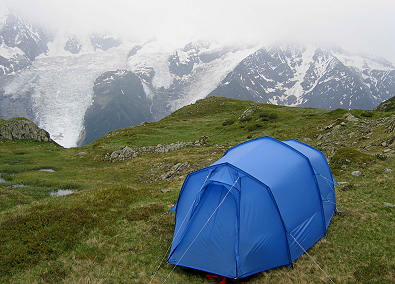
The GR5 runs from Thonons les Bains on the edge of Lac Léman, through the French Alps, past Mont Blanc, south to Nice on the Mediterranean. The route goes around the highest bits while trying to stay above the valleys, but it does drop quite regularly down to towns where you can buy food. In general you can buy food every few days or better. However, this is a very popular walk, and you can do most of it (if not all of it) without a tent, by staying in local 'Refuges' and Gites (some of these were more like 2-star country hotels really). As far as we could see, few overnight walkers in Europe actually own a tent: we called them 'refugees'. But there is a hazard: many of these Refuges are within a short distance of a road end, and they are often full of pre-booked tourists. When you start running into hordes of day walkers you know you are close to one of the Refuges (and a car park).
There are several significant deviations possible along the way, including the Tour du Mont Blanc (TMB) and the GR52. We did both of these. The TMB goes around the Mont Blanc massif and is hugely popular - which does introduce a few problems in its own right. It is (mainly!) fairly easy compared with the GR5. The GR52 is an alternate ending to the GR5, bypassing the long descent into the Nice valley and the mega-city of Nice. Instead it goes through the spectacular Vallée des Merveilles and ends up very suddenly at Menton, also on the coast. Unlike the TMB, this route is considerably harder than the GR5.
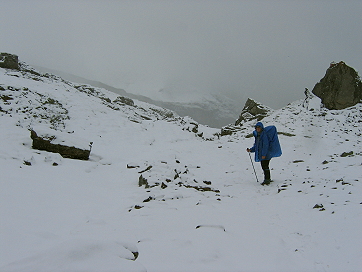
There are none on the GR5: this is a well developed and very much frequented walking track, and you do not need any 'technical' gear (ropes etc). On the other hand, it does go through alpine country, and you have to be prepared for alpine weather - which can be anything at all at any time of the year. Indeed, we copped most of it as can be seen in some of the photos. You certainly do need to be carrying the right clothing - and to be able to keep it dry inside your pack.
I should mention that the season we were there was especially bad. Well, it was worse than 'normal', although with global warming running flat out these days, who know what the future will hold? More variability is certain. That said, I should add that as we went south the weather improved steadily. In fact, south of the town of Modane, about half way along the track, the weather cleared up significantly. Some of this improvement was due to the 'weather' changing, but a lot was due to the fact that we were going away from the main Alpine region towards the Mediterranean. In the wide photo at the top, taken a few days south of Modane, the weather was obviously a lot better. In fact, as we got close to the Med it started to get very hot. The last few days were very hot, so your gear has to be rather flexible.
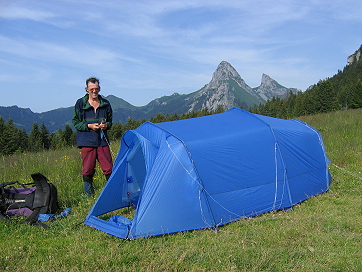
Camping is not permitted for a major part of the route. In this case overnight bivouacs are included in the ban. There seem to be two reasons for this ban, although you might consider me slightly biased in my comments. The first reason is the sheer popularity of some sections of the walk. If everyone camped every night (extremely unlikely: few even own a tent) there might be some impact: 'they' claim that the tents would flatten the grass. The Parc National de Vanois (PNV) has a complete ban, ostensibly for this reason. Against this logic however we may note that the Parc authorities allow many thousands of sheep and cattle to live on the high pastures for all the summer season. I leave it to you to decide which of the sheep/cows or the tents would have the greater impact over the greater area. Oh yes - I should add that while camping is banned, the building of mega-ski-resorts is not. Ah, but both the local farmers and the resort owners have political clout, don't they?
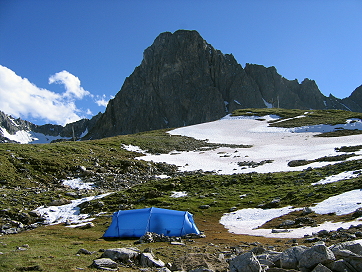
I should add that we saw enough campsites scattered here and there for us to realise that some Europeans hold similar views on the matter - and ignore the bans. It is easier to do this if you are in a small group and have camo-coloured tents of course. Ours is a rather bright blue, as you can see. In the photo to the right we had reached the Club Alpine France (CAF) Refuge de Palet just below the Col du Palet by late afternoon, we but didn't really want to stay in yet another Refuge. So we popped over the col, out of the National Park (and its no camping zone) to a delightful spot on the other side all to ourselves. Fortunately the wind died as night fell so we didn't need the little stone wall I had built at the right-hand end of the tent. Yeah, cols can be windy places at times!
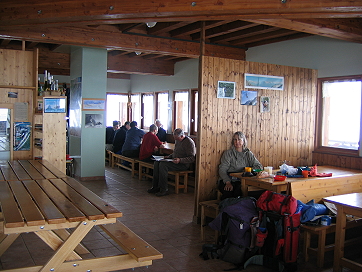
The second reason for the ban is that the local farm/Gite/Refuge owners in some areas have imposed the ban themselves. Guess who gets to profit if people are not allowed to camp somewhere, but have to stay in the local Gite/Refuge? However, the rules do change if the Gite or Refuge is full: then the owners will allow you to camp outside - among the dung left there by their cows. Mumble! However, in some places you 'need' a Refuge: on the Col de la Croix du Bonhomme at 2443 metres we had some serious snow and bad weather (photo above), but the CAF have placed some very nice Refuges at strategic high places. They are usually pretty good, and can hold a reasonable number. The one shown here can accommodate 113 people - at least. If more turn up and the weather is foul ... they can handle it. They do have spare mattresses, and the kitchens are pretty big.
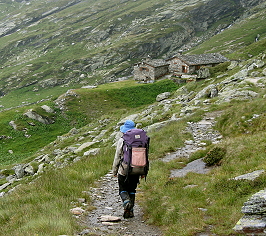
Ah well, this is how most of the Europeans go walking. It can be very comfortable (and extremely light-weight!), especially when the weather is foul. We only ran into a couple of bad Gites in the whole time - actually on the very popular Tour du Mont Blanc. The owners of the worst one were ... strange, and incredibly penny-pinching. The other 'Refuge' was really a rather expensive hotel - with a monopoly on the area. The dinner was a bit thin too.
For the GR5 you can usually buy the FFRP guide books in the towns near the beginning and end of each section (one section per book). They contain strip topo maps and are quite sufficient in themselves for navigation. In fact, we didn't buy any topo maps for the GR5. I should add that the track is quite well marked with track markings ('balisage') and with signposts at the junctions and cols, as shown in the photo above.
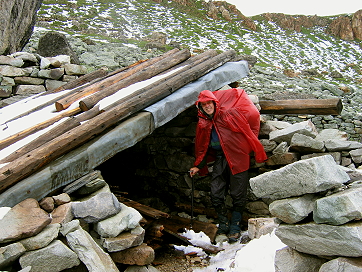
In addition to the navigation details, the guides include information about all the accomodation on the track and within a reasonable distance from the track. This can be very valuable if you are going without a tent and relying on the Gite/Refuge system. OK, this list covers real accomodation: shelters or 'abris' like the one to the left below the Col de Bresson get mentioned in the text, but usually with some sort of warning words about being less than four star! But since we had been going for several hours in a storm without any rest of food, it was sort-of welcome. But we never saw the views the guide book raved on about from the col!

In addition to the navigation stuff, the guide books usually have little bits of information about other things you see on the track, like the Chateau Queyras shown here. It commands the valley and is largely intact - and to our astnishment, it's privately owned. No, not by some left-over of the French nobility, but by a local family who bought it after WW II when no-one else wanted it! You can tour it for a small fee: we did. So if you want to see more of the country than just the track in front of you, the guides provide a start.
There is another source of local information worth using if you want to branchout from just looking at the track: the local Tourist Information Centres or 'TICs'. They are not everywhere, but they love tourists of any sort, even scruffy walkers (of whom there are a surprisingly large number), and often have little local sketch maps and guides to local sights - all free. They also always have lists of accomodation (four star to camping grounds) in the towns, which can be really valuable if you have to stop for the night in a town in order to do some food shopping. A frightening sight we encountered a few times was a small group of novices or tourists trying to travel a section of the track using ONLY the sketch map from the local TIC. I checked some of these maps: they were often slightly wrong in some details. That is pushing it a bit far!
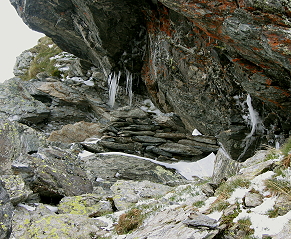
We took our normal Australian walking gear. I took our lightweight summer tent as past experience suggested it would be enough. We took light-weight summer sleeping bags and they were enough - just. But the weather was pretty bad some of the time - sub-zero the day I took the photo to the left. We also took our deluxe 50 mm thick 3/4 length Therm-a-Rests. For clothing we had our normal Taslan bushwalking clothing (smock and trousers), a set of thermals (tops and longs), and some Bozeman Mountain Works Cocoons: light synthetic duvet jackets. These were new, but wonderful. Rainwear were our very versatile silnylon ponchos, which coped with both brief light showers and bad sleet and snow. You can see mine and Sue's in some of the photos. Sue took a pack cover because her Macpac Torre pack is made from polycotton canvas, but I didn't as my UL pack is made from waterproof X-Pac fabric. Footwear was typically in the approach shoe class - we both ended up with Salomon Extend Lows, but a size larger (each) than we started with! I took Darn Tough Vermont socks, while Sue took slightly thinner Ultimax socks to fit her starting shoes. Our normal broad-brimmed bushwalking hats were essential.
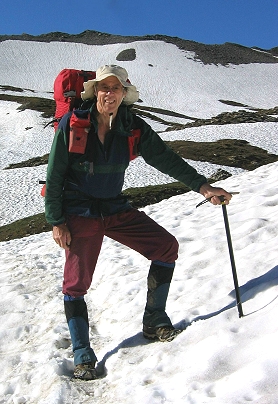
I took a light ULA Helix ice axe on the GR5 and used it in the snow - several times. Such was the weather. Actually, the Helix is sold as a 'Potty Trowel' as it isn't certified, but I found it quite adequate. Sue took a Titanium Goat carbon fibre trekking pole and used it in the snow too.
I took a Hydro-Photon Steripen Adventurer to treat our water: this is a UV light system which runs on batteries. No chemicals, no waiting. We did not have to use it that much as the town water supplies are now all treated: all the public fountains and taps are drinking water.
For cooking I took my Snow Peak GST-100 stove, an MSR Titan pot and an MSR Titan kettle. These worked just fine. Well, actually, the stove wore out at the mating thread so I had to replace it half-way through the trip, but it was 10 years old and it had been used an awful lot.
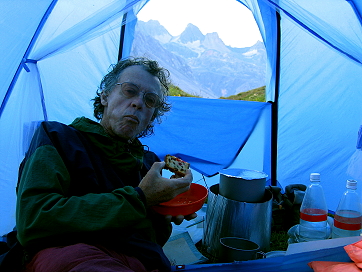
We each took our credit cards (two: one in reserve) and used them at ATMs. You won't find ATMs in the very small towns, but they are in the larger towns and the larger shops would all take our credit cards. Five seconds and the transaction was approved, from our bank in Australia. Well, mostly - a few card readers would not read Sue's credit card, but that was the fault of the reader. The vendor usually punched the data in by hand when that happened. Really, money has ceased to be the hassle it used to be. You will need some cash for small food purchases of course.
As I wrote on the GR10 page, forget about expecting to buy what you normally take walking in Australia: you are not in Australia. But there are plenty of alternatives if you are flexible. Some walkers bought all their meals in refuges and bar/restaurants. One can become quite accustomed to doing this, and it saves a lot of weight! However, we were tenting a lot of the time and cooked our own meals. It gave us far better camp-sites and views, and was a lot more peaceful.
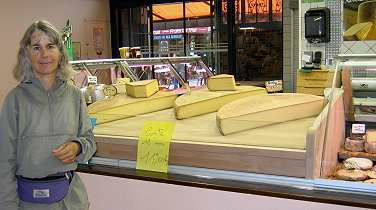
Breakfast cereal in France is a dead issue. They don't know about it. OK, I was sometimes able to buy something resembling muesli, and powdered milk was quite readily available, but a lot of the time we had BBJ and tea/coffee for breakfast. Good solid country bread called 'pain de campagne', with lots of butter and jam and cheese. That's the problem with being able to go shopping every couple of days: there is no inhibition about spreading the butter and jam and cheese rather thick! The local 'saucisson sec' wasn't bad either. But creamed honey was unknown.
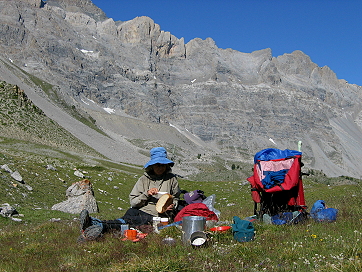
In fact, we ate a lot of bread. They make real bread there, unlike the sliced white Wettex you get in Australia. French 'Baguettes' are well known : long loaves of crunchy crusty white bread, which put crumbs everywhere and are full of holes. Can I recommend 'pain de campagne' instead? It is a solid wholemeal or part-rye bread which lasts well and is even better. Unlike Wettex, it has a real taste too. We stored our bread in a large plastic bag inside a large nylon bag to stop it from drying out. Buying it unsliced definitely helped preserve it too.
Butter and jam are widely available, and the jams are rather good, with lots of local berries. Of course, there are many, many different cheeses, all interesting. There's cow cheese, sheep cheese and goat cheese. Personally, we thought the cow cheeses were the best, but tatstes vary. The local Brie cheese (and variants) in France sells for absolute peanuts, and we ate kilos of it. Sue would come out of the cheese shop clutching half a kilo of Brie and I would ask who is going to carry that? But somehow the weight never lasted ... I also bought by accident some over-ripe soft cheese one time: we buried it early the next day to stop it running around the place. I also got stuck into a bit of the local salami-style sausage called 'saucission sec'.
The rest of the food, and the shopping, was just like on the GR10 and GR11 trips. I have given more details there.
The message here is simple: use gas. It will have to be Campingaz as that's what is available: for this you might as well buy a small French Campingaz stove. They are cheap enough. We saw very few petrol stations, and I don't remember seeing anything resembling Shellite or Coleman fuel for sale in more than one or two places. I didn't see kero more than once or twice, and metho was about the same.
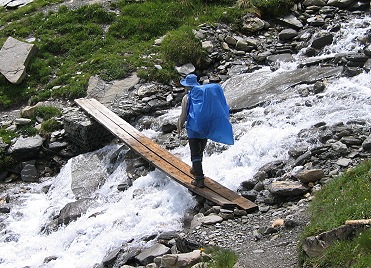
This was a rather long trip: three months of fast walking and a lot of climbing. We keep saying we will take it easy next time, but we never do. Several points did come out of the trips.
© Roger Caffin 10/10/2007